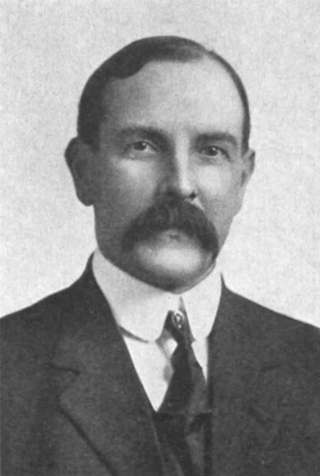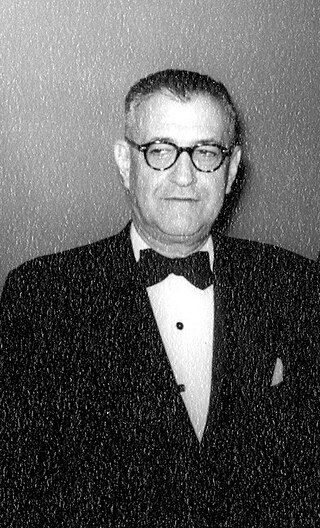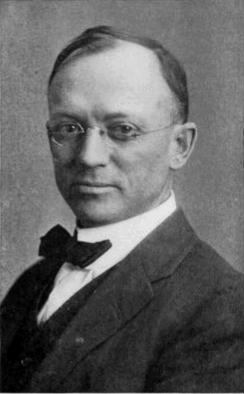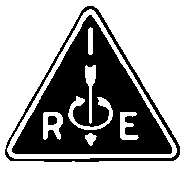
Charles Proteus Steinmetz was a German-American mathematician and electrical engineer and professor at Union College. He fostered the development of alternating current that made possible the expansion of the electric power industry in the United States, formulating mathematical theories for engineers. He made ground-breaking discoveries in the understanding of hysteresis that enabled engineers to design better electromagnetic apparatus equipment, especially electric motors for use in industry.

The Institute of Electrical and Electronics Engineers (IEEE) is a 501(c)(3) professional association for electronics engineering, electrical engineering, and other related disciplines with its corporate office in New York City and its operations center in Piscataway, New Jersey. The IEEE was formed from the amalgamation of the American Institute of Electrical Engineers and the Institute of Radio Engineers in 1963.

Arthur Edwin Kennelly was an American electrical engineer.

Henryk Władysław Magnuski was a Polish telecommunications engineer who worked for Motorola in Chicago. He was a primary contributor in the development of one of the first Walkie-Talkie radios, the Motorola SCR-300, and influenced the company's success in the field of radio communication.
The American Institute of Electrical Engineers (AIEE) was a United States-based organization of electrical engineers that existed from 1884 through 1962. On January 1, 1963, it merged with the Institute of Radio Engineers (IRE) to form the Institute of Electrical and Electronics Engineers (IEEE).
George Harold Brown was an American research engineer. He was a prolific inventor who held more than 80 patents and wrote over 100 technical papers.

Walter Ransom Gail Baker was an American electrical engineer. He was a vice president of General Electric, and was Director of Engineering for the Radio Manufacturers Association. At the urging of James Lawrence Fly, Chairman of the Federal Communications Commission (FCC), Baker founded the National Television System Committee, or NTSC, in 1940. He served as president of the Institute of Radio Engineers (IRE) in 1947.
The IEEE Edison Medal is presented by the Institute of Electrical and Electronics Engineers (IEEE) "for a career of meritorious achievement in electrical science, electrical engineering, or the electrical arts." It is the oldest medal in this field of engineering. The award consists of a gold medal, bronze replica, certificate, and honorarium. The medal may only be awarded to a new leap/breakthrough in the technological area of science.

The IEEE Medal of Honor is the highest recognition of the Institute of Electrical and Electronics Engineers (IEEE). It has been awarded since 1917, when its first recipient was Major Edwin H. Armstrong. It is given for an exceptional contribution or an extraordinary career in the IEEE fields of interest. The award consists of a gold medal, bronze replica, certificate, and honorarium. The Medal of Honor may only be awarded to an individual.
The initially called AIEE Lamme Medal was established in 1924 by the American Institute of Electrical Engineers (AIEE) to recognize members for 'meritorious achievement in the development of electrical apparatus or machinery.' The medal was named in recognition of Benjamin G. Lamme, Westinghouse' chief engineer, who amongst others was responsible for the construction of the Niagara Falls generators.

Alfred Norton Goldsmith was a noted American electrical engineer.
Lawrence Christopher Frank Horle was a noted American electrical engineer.
Dr. Leonard F. Fuller was a noted American radio pioneer. In 1919, Fuller earned a PhD degree at the Stanford Department of Electrical Engineering. In World War I, he was part of the antisubmarine group of the National Research Council, and charged with the design and installation of the "high-power transoceanic radio telegraph stations" built by the United States Army and Navy. He held 24 patients for inventions before his death. He spent time as chair of the electrical engineering department at University of California, Berkeley, and then was acting professor of electrical engineering at Stanford University from 1946 until he retired in 1954.
Donald Glen Fink was an American electrical engineer, a pioneer in the development of radio navigation systems and television standards, vice president for research of Philco, president of the Institute of Radio Engineers, General Manager of the IEEE, and an editor of many important publications in electrical engineering.
The Proceedings of the IEEE is a monthly peer-reviewed scientific journal published by the Institute of Electrical and Electronics Engineers (IEEE). The journal focuses on electrical engineering and computer science. According to the Journal Citation Reports, the journal has a 2017 impact factor of 9.107, ranking it sixth in the category "Engineering, Electrical & Electronic." In 2018, it became fifth with an enhanced impact factor of 10.694.
William Alden Edson was a scientist and engineer specializing in vacuum tube oscillators, radar, antennas and microwave technologies. His work spans universities, research institutions and commercial ventures. He taught at Illinois Institute of Technology, Georgia Institute of Technology and Stanford University.
Emmett Finley Carter was an electrical engineer that worked at several companies; most notably, he was in upper management of Sylvania Electric Products and was the director, and later president, of SRI International from 1956 to 1963.

Robert Henry Marriott (1879-1951) was an American electrical engineer, and one of the first persons to work in the field of radio communication. In 1902 he engineered the first commercial radiotelegraph link established in the United States by a U.S. company, connecting the island of Santa Catalina with the California mainland. He founded the Wireless Institute professional society in 1909, which was merged in 1912 with the Society of Wireless Telegraph Engineers to form the Institute of Radio Engineers (IRE), and served as the IRE's first president.
IEEE Transactions on Aerospace and Electronic Systems is a bimonthly peer-reviewed scientific journal published by the IEEE Aerospace and Electronic Systems Society. It covers the organization, design, development, integration, and operation of complex systems for space, air, ocean, or ground environment. The editor-in-chief is Gokhan Inalhan. According to the Journal Citation Reports, the journal has a 2020 impact factor of 4.102.







